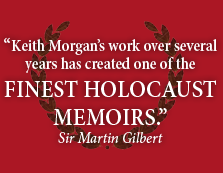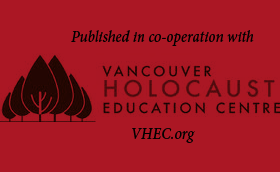Ruta’s Warning to the Youth of Today
An account of one of Ruth Kron Sigal’s addresses to high schoolers
Vancouver, Canada – March 2001.
The silence that greeted Ruta Kron Sigal’s closing words was not the polite quiet in which she began to deliver her message to the high school students twenty minutes earlier.
Now it was a stunned silence.
During the first few minutes, one or more of the 60 or so chairs occasionally creaked as its teenaged occupant restlessly shifted position. Less frequently, a stage whisper from the rear was faintly audible as it penetrated the front row of the large room in the Vancouver Holocaust Education Centre.
Nevertheless, Ruta’s dramatic story of her family’s escape from the clutches of the Nazis and her chilling recollection of how many fellow Jews they murdered during their bloody occupation of her native Lithuania soon glued the youngsters to their seats and tied their tongues.
Brows furrowed while young fingers nervously stroked and tapped chins. At times, there were furtive sideways glances from boys checking to see how their friends were dealing with all this talk of real death and destruction. Strange, given the long hours many had undoubtedly spent unleashing death and destruction via electronic war games on their home computers. They noticed the girls with tears in their eyes and quickly looked away, perhaps fearing an errant droplet of water would leak from their eyes.
A cough or a loud sigh might actually have provided a welcome break in the tension that now filled the room. There had not been a single auditory disturbance since the first five minutes had ticked by. Only the naturally amplified sound of Ruta, nervously swallowing to lubricate the lump in her throat punctuated her shaky delivery. As the head of a large university women’s program, she had frequently spoken with confidence and directness to much larger audiences. This was different. Her personal story, no matter how many times she told it, never got any easier to tell.
“Just before World War Two, in Siauliai where I lived – which we knew better as Shavli or Shavl – was a thriving, small city in the north of the country. And at that time the Jewish population was 5,360,” Ruta informed them, in the same straight forward, just-the-facts-manner, a social studies teacher might address this same group back at school.
The vivacious grandmother, whose attractive appearance belied her painful past, even smiled as she talked about the richness of Jewish family and cultural life. For her father Meyer Kron, mother Gita and little sister Tamara lived a blessed life prior to the outbreak of the Second World War.
Nevertheless, the sentences she spoke a few minutes later wiped a smile from her face that would not reappear until much later when she spoke lovingly about those who risked their lives to hide her and save her parents.
“The Jewish population grew to 6,500 as Polish refugees and other Jews from elsewhere tried to outrun the advancing Nazis. About 1,000 of them fled into Russia a few days prior to the German takeover of Shavl on June 25, 1941. In the first two weeks of the occupation, 1,000 Jews were murdered by the Nazis and many of our own neighbours.”
Almost a month later, the Nazis ordered the remaining Jews to move to two ghettos in the poor part of the city, while that shabby neighbourhood’s former residents helped themselves to the homes of the displaced Jews.
“A further 1,000 Jews, who were sent to nearby Zhager, were killed there over the last four months of the year and another 750 Jews who were forced work in other nearby villages were also wiped out.”
The facial expressions on the youthful audience matched the speaker’s for seriousness and concentration, and remained that way until she finished. She paused to allow the numbers to have their impact. It was as though she was giving the audience an opportunity to perform some mental arithmetic.
Ruta continued teacher-like: “If you are good at math you will have figured out that by the end of the year more than half of the original Jewish population was murdered.”
The story throughout Lithuania was the same; she told them with a despairing sigh. At the beginning of the war, more than 200,000 Jews called Lithuania home. By the time the last shot of the war was fired around four per cent of them remained and it no longer felt anything like home to those that survived.
Ruta’s voice grew a little louder and the words came a little quicker as she recalled:
“My parents’ determination to survive grew as members of our family and good friends died or suffered at the hands of the Nazis or the Lithuanian fascist collaborators.
“They became more inventive and daring in their bid to keep our family together. No matter what our tormentors did we were not going to allow them to beat us into submission.”
She went on to tell some of the stories of bravery and cowardice recorded in the chapters that precede this one. At this point, many fellow Holocaust survivors would have stepped back and asked if there were any questions. Ruta pressed on. She had something to say about why the young audience before her should care about this piece of history from the last century.
“I’m sure you must think my story is horrific. I do too. It happened many years ago so perhaps you think it means nothing today but if you do you would be wrong.”
Her mild rhetorical admonishment hung in the air briefly. There was still no discernible movement among the audience.
“My story was locked away in a mental closet of my own making for many years,” she explained, preparing to bare a little more of her soul.
“Our elders told us: ‘You did not suffer. You were safe. You were hidden in the homes of rescuers.’ We ‘the hidden children’, as we are known, were left feeling that our stories were not as important as those told by older people who had survived Hitler’s concentration camps – Auschwitz, Dachau to name but two of the death camps.”
Unfortunately, that suppression of memory made many younger survivors victims again. With no outlet to confront their past, they found themselves unable to deal with life today or relate healthily to their spouses, their children and their grandchildren. That said, many were so emotionally damaged by the experience of being removed from their families and, in some cases, coerced to convert to Christianity it is likely that they would remain silent whether their elders had given them ‘permission’ to speak or not. Fortunately, today, there are support groups for child survivors and their offspring.
Ruta continued: “A few years ago I reached that age when people often begin to reflect on their life. I needed to come to terms with it and fortunately I had a loving, understanding family that helped me wrestle with my past.”
For this trained psychologist and counsellor, the disturbance of old, painful memories long locked away was at first a self-awareness exercise, designed to bring her some peace in her later years. Then events around the world persuaded her she must emerge more publicly from her mental closet to tell her story. This initially self-indulgent exercise had revealed to her that she had a valuable lesson to share with today’s youth. If she chose not to tell her story then it would die along with her because she was among the last living witnesses to this most terrible era of human history. This was an uncomfortable realization for such a private person.
The memories of survivors and witnesses to the Holocaust are sometimes incomplete and accounts may be coloured by the bitterness and trauma of their experience. The Holocaust deniers pounce upon such human failings and the historical inaccuracies they produce as proof that it never happened or is no more than a wild exaggeration. Ruta anticipated that these members of a generation brought up on the wonders of the Internet where deniers freely spread their hate-filled messages would raise these doubts about the believability of Jewish claims.
“It happened. I was there,” Ruta testified succinctly, adding.
“The records of the Nazis prove that it happened. The mountains of Jewish hair in the Auschwitz museum prove it happened. The broken Zyklon B canisters used to gas thousands of Jews before sending them to the ovens also on display prove it happened.”
If the students believed that genocide was an aberration of the past Ruta quickly disabused them of that hopeful notion.
“I saw the sickening TV footage of the genocide in Rwanda and later in the Balkans,” she explained. “Ethnic cleansing is the new phrase coined to describe the slaughter of one particular race or tribe of people. The term sounds a little too ‘clean’ for me. Let us call this form of cold-blooded mass murder by the dirty word it is – genocide.
“It wasn’t the Jews that were victimized this time but I have to ask how long will it be before somebody comes after us again?”
She paused, walked a couple of steps, and answered herself.
“Anti-Semitism is on the rise again, even here in Canada where we pride ourselves on being liberally minded and tolerant of others.”
This was not just a ‘feeling’ or a pet theory it was a truth. A year later news stories independently confirmed her fears when they revealed that Canada had recorded 197 anti-Semitic incidents in just six months.
She politely thanked the youngsters for their attention. There was a loud sniffle from a blonde girl at the back, which triggered more sniffles. Ruta’s powerful story always had the same effect on the kids. She took heart in such a reaction daring to hope that the new generation will learn from history and not be doomed to repeat its errors, to paraphrase an oft-quoted yet frequently unheeded piece of popular wisdom.
One after the other a dozen youngsters approached Ruta to embrace her, as their classmates quietly filed out. They were long, heartfelt hugs. The high school students spoke no words. None seemed necessary, as Ruta had said it all.
A little more than a year later, Ruta thought it was time to open her mental closet doors still wider, to revisit her childhood years when she bore the name Ruta. She decided she must record the Holocaust experience of the Krons of Shavl (Siauliai) and she completed that task just before her passing on December 16, 2008.
Ruta was driven to complete the task by a small news item she spotted back in 2002. Two more that followed served only to convince her of the wisdom of that decision.
* * *
Siauliai, Lithuania, April 20, 2002: On this anniversary of Hitler's birthday, swastikas were found painted on almost all of the gravestones of Jews in Kristijonas Donelaitis cemetery of this small Lithuanian centre.
* * *
Siauliai, Lithuania, January 2003: Neo-Nazis disrupted Hanukah celebrations. On Christmas Eve, somebody pulled down a menorah that was to be lit that evening. Activists from the Lithuanian National Democratic Party, the country’s main neo-Nazi party, which has some seats on the local city council, held a rally during the ceremony holding anti-Semitic signs and shouting insulting slogans.
* * *
Vilnius, Lithuania, February 2004: Lithuanian Poll on Ethnic Tolerance Released. Lithuanians are generally tolerant towards dark-skinned people, extremely intolerant towards Roma (Gypsies), and split on attitudes towards Jews. 30.9% of respondents had positive feelings towards Jews, 20.4% had a negative attitude, and 54.8% were neutral. The January 29, 2004 edition of the news magazine Veidas contains an article in which the author argues that if the question about Jews were to include the contentious issue of the restitution of Jewish property lost during the Holocaust, tolerance towards Jews would instantly disappear.



